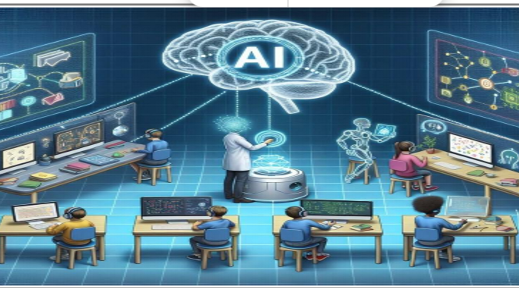By Lawal Mozidah Olawumi, Musa Lateefah Ebunoluwa, Aransiola Olawale Taofeek, Mahmud Aliyah Titilayo
Artificial Intelligence popularly known as AI is no longer just a futuristic idea. It’s quickly changing how students learn and how teachers teach. AI refers to computer systems designed to perform tasks that typically require human intelligence—such as recognizing speech, analyzing data, making decisions, or learning from experience. In practice, this means AI can act like a smart assistant that helps students solve problems, answer questions, and adjust lessons based on individual needs.
During an interview with Olusegun Joe-Alabi, Founder and CEO of Makkan Foundation and a tech innovator, explains that, “AI is like teaching computers to think and learn the way humans do. For students, think of AI as a smart assistant that can personalize learning based on strengths and weaknesses.”
It’s almost hard to believe that AI—this thing quietly powering our learning apps—started out as a wild research dream decades ago. Back then, scientists imagined machines that could think like humans, but most people never expected to see it in action, let alone in a school setting. Fast forward to today, and we have AI tools recommending study topics, grading essays, and even adjusting lessons on the spot. What felt like science fiction is now shaping how we learn.
One major benefit of AI in schools is personalized learning. Joe-Alabi says, “AI can adapt to each student’s pace and style, something traditional classrooms struggle with due to limited time and resources. It’s especially useful for revision, practice, and mastering foundational skills.”
Many students already use AI-powered tools—sometimes without realizing it.For example, language apps like Duolingo adapt lessons in real time, turning practice into a personalized game. Writing assistants such as Grammarly scan essays in seconds, giving instant feedback on grammar and tone.
Platforms like Khan Academy use AI to recommend topics based on what a student struggles with. Even more advanced tools like Carnegie Learning analyze student answers and adjust problem difficulty instantly to keep learners challenged but not overwhelmed.
In Nigeria, local platforms like uLesson and Edukoya are also harnessing AI. They help students prepare for exams with tailored videos, quizzes, and personalized learning paths.
“Most times I feel more comfortable asking questions on AI apps than raising my hand in class,” says Oyeleke Barakah, a 100-level student at the University of Ilorin. For students like her, AI offers a judgment-free zone where they can learn quietly, rewind lessons, and practice until they fully understand.
While AI is growing rapidly, not everyone feels it can fully replace human teachers. Mahmud Temitope, a 300-level student of Anatomy at the University of Ilorin shared her concerns:
“AI doesn’t have the emotional intelligence that a teacher would. A teacher can tell when a student is sad or stressed but an AI doesn’t do that.” Her words point to an essential truth: while AI can adapt to data, it cannot yet connect emotionally with learners or respond to subtle cues of distress, motivation, or confusion in the way a human can.
AI’s influence is still growing. A 2024 HolonIQ report estimates the global AI education market will top $20 billion by 2027, growing at around 45 percent annually. This shows the world’s strong belief in AI’s potential.
Still, challenges exist. “Access is a big hurdle,” Joe-Alabi points out. “Not all schools have the infrastructure or training to use AI tools properly. Protecting student data and ensuring ethical use also require attention.”
In many places, especially in developing countries like Nigeria, limited internet and technical support slow AI adoption in education.
Despite this, AI-based education programs are already making a difference. From adaptive language apps to platforms that identify learning gaps, AI is helping make education more personal, efficient, and accessible.
As AI technology evolves, education must keep up. Teaching students skills like critical thinking and digital literacy will be key to thriving in an AI-driven future. For now, AI is a tool that complements traditional teaching, not a replacement.
